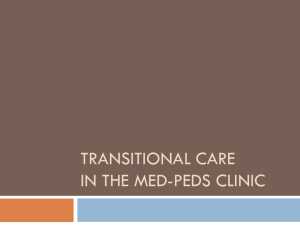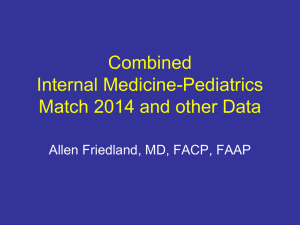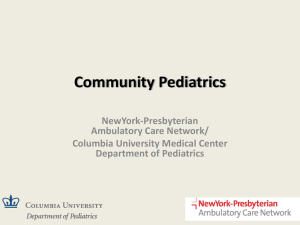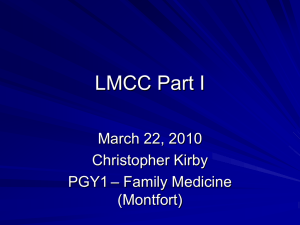2013 NMPRA Speakers` Kit - The National Med
advertisement
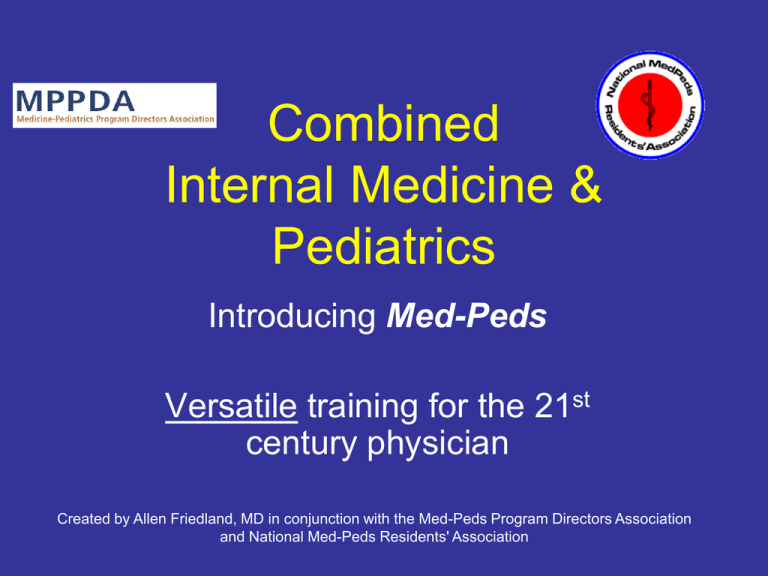
Combined Internal Medicine & Pediatrics Introducing Med-Peds Versatile training for the 21st century physician Created by Allen Friedland, MD in conjunction with the Med-Peds Program Directors Association and National Med-Peds Residents' Association Residency Programs Program Type Training Length Type Pediatrics 3 years Medical Internal Medicine 3 years Medical Family Medicine 3 years Medical Med-Peds 4 years Medical Ob-Gyn 4 years Surgical General Surgery 5 years Surgical What is a Pediatrician and What is an Internist? Pediatrician • A physician who specializes in the development, care and diseases of children Internist • Doctors who focus on adult medicine- the prevention and treatment of adult diseases • Infants, children, adolescents and young adults from birth to age 21 • Specially trained to solve puzzling diagnostic problems • Focuses on prevention, detection and management of physical, behavioral, developmental and social problems • Equipped to deal with all problems rare or common, simple or complex • Developmentally oriented Handle severe chronic illnesses Situations where several different illnesses may strike at the same time American Academy of Pediatrics (Pediatrics 101) American College of Physicians (Doctors for Adults) What is Med-Peds / Who We Are • Physicians for children (pediatrics) • Board Certified Pediatrician (children) • 2 years of training instead of 3 • Physicians for adults (internal medicine) • Board Certified Internist (adults) • 2 years of training instead of 3 History of Med-Peds 1949 Two year rotating internship at University of Rochester 1960’s One year combined internship at North Carolina Memorial Hospital 1967 Boards approve combined training 1977 North Carolina formalizes training 1982 University of Rochester formalizes training History of Med-Peds 1989 First formal training guidelines 1991 Program Director’s Association formed Med-Peds section of AAP created 1997 National Med-Peds Residents’ Association is created 1997 Congress supports med-peds training pay AAP/AMA/ACP support dual listing 2006 Accreditation of med-peds programs Med-Peds program requirements Versatile Med-Peds Physician Treat common diseases Survivors of chronic health conditions from childhood Global Health Versatile Med-Peds Physician Prevent disease in families Adolescents have special needs ICU settings The Changing Epidemic Child diseases in adulthood 1. Congenital heart disease 2. Cystic fibrosis 3. Sickle cell disease 4. Childhood malignancies 5. Spina Bifida 6. Autism Adult diseases in childhood 1. Diabetes 2. Obesity 3. Hypertension 4. Sleep apnea 5. Hyperlipidemia Med-Peds Requirements Transitions Resident Practice Med-Peds Time Required specialties Accredited Programs Subspecialty Electives General Ped & General Med ICU time Internal Medicine Number of months Pediatrics Number of months General Inpatient Medicine 8 General Inpatient Pediatrics 5 Medical Intensive Care Unit 1-2 Pediatric Intensive Care Unit 1-2 Cardiac Intensive Care Unit 1-2 Neonatal Intensive Care Unit 2-3 Geriatrics 1 Newborn Nursery 1 Emergency Medicine 1 Emergency Pediatrics and Acute Illness Pediatrics 3 36 clinics Behavioral-Developmental per year Adolescent Medicine 2 Outpatient Med-Peds continuity Subspecialty experience (e.g. Infectious Diseases, Nephrology, etc.) Overall Ambulatory Experience (minimum) 4 33% Subspecialty experience (e.g. Infectious Diseases, Nephrology, etc.) Overall Ambulatory Experience (minimum) 4 40% Med-Peds Match 2013 (77 programs with 366 positions) NE: 2 spots MI(6): 26 spots MN: 12 spots KY(2): 10 spots WA IN: 14 spots OH(4): 25 spots WI (2): 8 spots IL(5): 24 spots ME: 3 spots NY(4): 18 spots MA(4): 19 spots CT: 4 spots RI: 4 spots PA(4): 16 spots NJ(2): 5 spots DE: 4 spots DC: 4 spots MD: 8 spots ND MT ME MN VT WI OR ID SD WY NH NY MI MA RI CT PA IA NE NV NJ IL UT OH IN CO DE WV KS KY MO VA CA TN AR SC MS AL CA (4): 18 spots UT: 3 spots AZ: 6 spots NC OK NM AZ TX MD DC GA LA HI FL OK(2): 6 spots AR: 6 spots TX(2): 14 spots LA(3):14 spots MO (3): 13 spots KS: 2 spots VA:6 spots WV(3): 6 spots NC(3):18 spots MS: 4 spots AL: 7 spots FL(2): 8 spots TN(2):14 spots SC(2):8 spots Med-Peds Graduates 9000 8000 7000 6000 5000 4000 3000 2000 1000 0 1975 1980 1985 1990 1995 2000 2005 2010 2015 Where are the med-peds grads? Data: courtesy of the American Board of Pediatrics; Feb. 2009 (Total 4207 initially certified) Alaska 9 70 15 4 7 11 10 117 74 28 21 154 21 258 12 42 45 30 42 222 98 184 44 124 180 287 88 50 99 47 98 114 252 13 55 264 265 3 24 13 83 84 136 28 Hawaii 167 22 64 95 14 10 Choosing a Career in Combined Internal Medicine and Pediatrics: Insights From Interns Other 9% Family Med 18% Medicine 41% Alternate careers considered by Med-Peds interns prior to residency Peds 32% Melgar, T; Frohna JG. “Choosing a Career in Combined Internal Medicine and Pediatrics: Insight From Interns”. Family Medicine. 2007;39:326-330 Choosing a Career in Combined Internal Medicine and Pediatrics: Insights From Interns MP IM Peds FM Other Considered as a career 86.8% 55.2% 50.7% 33% 19.1% Contacted programs 93.8% 30.6% 29.9% 20.8% 8.3% Applied 94.8% 18.4% 17.4% 8.3% 4.2% Interviewed 94.8% 16.7% 14.2% 5.9% 4.2% Ranked 94.3% 12.9% 11.4% 3.6% 3.5% Melgar, T; Frohna JG. “Choosing a Career in Combined Internal Medicine and Pediatrics: Insight From Interns”. Family Medicine. 2007;39:326-330 The Effect of Dual Training in Internal Medicine and Pediatrics on the Career Path and Job Search Experience of Pediatric Graduates Senior Residents Med-Peds Pediatrics Equally prepared for primary care in both specialties 80% 77% Equally prepared for fellowships in both specialties 90% 87% Chamberain, J; Cull W; Melgar T; Kaelber D; Kan B. “The Effect of Dual Training in Internal Medicine and Pediatrics on the Career Path and Job Search Experience of Pediatric Graduates”. Journal of Pediatrics.2007; 151: 419-424 The Effect of Dual Training in Internal Medicine and Pediatrics on the Career Path and Job Search Experience of Pediatric Graduates Senior Residents Would choose same specialty again Primary Care Career Med-Peds Peds 90 93 55 50 Subspecialty Career 18 31 Hospitalist Career 17 8 Other Career 10 11 Chamberlain, J; Cull W; Melgar T; Kaelber D; Kan B. “The Effect of Dual Training in Internal Medicine and Pediatrics on the Career Path and Job Search Experience of Pediatric Graduates”. Journal of Pediatrics.2007; 151: 419-424 The Role of the Med-Peds Physician in a Changing Medical World • • • • Editorial on the 40th birthday of med-peds Shift in career plans during residency Hospitalist “… med-peds graduates are well positioned to adapt to a changing medical landscape”. Frohna J. The Role of the Med-Peds Physician in a Changing Medical World. J of Pediatrics. 2007;151:338-339. Impact on Categorical Programs • 40% of pediatrics programs have a medpeds program. Of all pediatric residents, med-peds residents are approximately 14% of the total • 20% of medicine programs have a medpeds program. Of all categorical medicine residents, med-peds residents are approximately 9% of the total Women and Med-Peds 80% 70% 55% 60% 50% Med-Peds 40% Peds 30% IM 20% Family Practice 10% 0% 1992 1994 1996 1998 2002 2006 2008 2011 American Board of Pediatrics Annual Report 2007 American Academy of Family Practice web site Jan 2008 National GME Census 2011 The Med-Peds Puzzle Complete both Pass both Learn both Practice both Is It Possible to Complete Both? (1998-2002) 100% 95% 90% 85% 80% 75% 70% 65% 60% 55% 50% 91% 1998 1999 2000 2001 2002 Frohna J, Melgar T, Mueller C, and Borden S. Internal Medicine-Pediatrics Residency Training: Current Trends and Outcomes. Academic Medicine. 2004;79:591–596. Is it Possible to Learn Both? • Fundamental clinical skills in common: (history and physical, communication, organization) • Advanced clinical skills in common: (information processing, reasoning, hypothesis testing, deduction, epidemiology) • Some differences: manifestations/incidence of same conditions at different ages, nuances of treatment, neonatology and first two years of life John Chamberlain, MD 2002 Board Pass Rate From 1997-2013, the passage rate of med-peds residents is equivalent to the passage rate for categorical resident graduates for the Internal medicine boards. From 1997-2013, the passage rate of med-peds graduates is nearly equivalent to the passage rate for categorical resident graduates for those med-peds graduates taking the peds boards straight from residency. American Board of Pediatrics and American Board of Internal Medicine personal communication 2010 MPPDA Is it Possible to Practice Both? • About 50-60% of graduates go into primary care practice. The majority (between 77-93%) provide care for both adults and children. – 40% also have an academic appointment with a medical school • About 18-25% of graduates pursue fellowship and 50% provide care for both adults and children. – 60% also have an academic appointment with a medical school Freed G et al. Int med-peds physicians: Care of Children versus Care of Adults. Acad Med. 2005. Frohna J et al. Int med-peds Residency Training: Current Trends and Outcomes. Acad Med. 2004 Results from the National Ambulatory Medical Care Survey Age Distribution of Patient Visits to Primary Care Providers Recorded in the National Ambulatory Medical Care Survey from 2000-2006 ≤ 2 years/old 3-18 years/old 19-40 years/old 41-64 years/old ≥ 65 years/old 60 50 43% children 15% children 40 % 30 visits 20 10 0 Med-Peds Family Medicine Pediatrics Internal Medicine Fortuna, Ting, Kaelber and Simon. Characteristics of Medicine-Pediatrics Practices. Academic Medicine (84) 3; March 2009: 396-401 Fellowships and Subspecialties • • • • • Qualify for ANY IM or Pediatric fellowship. Ideal preparation for sub-specialization Equally competitive with categorically trained candidates. Added maturity derived from an additional year of training and discipline Combined fellowships: subject to negotiation. Fellowships After Med-Peds 1. Adolescent Medicine 2. Allergy-Immunology 3. Cardiology 4. Child Abuse 5. Clinical Cardiac Electrophysiology 6. Critical Care 7. Developmental-Behavioral 8. Emergency Medicine (peds only) 9. Endocrinology 10. Gastroenterology 11. General Medicine 12. General Pediatrics 13. Genetics 14. Geriatrics 15. Hematology-Oncology 16. Hospice and Palliative Care 17. Infectious Disease 18. Interventional Cardiology 19. Medical Informatics 20. Nephrology 21. Neurodevelopmental Pediatrics 22. Perinatology 23. Pulmonary 24. Rheumatology 25. Sleep Medicine 26. Sports Medicine 27. Toxicology 28. Transplant Hepatology Fellowship Choices: 1998-2002 Subspecialty Number Combined Cardiology 33 13 Infectious Diseases 29 17 Allergy/Immun 21 Primary Care 18 Endocrinology 18 Adult Pulm/CC 17 Peds ICU 17 Nephrology 17 11 Heme/Oncology 16 11 Adolescent Med 11 N/A Rheumatology 11 8 Pulmonary 10 8 Unknown 42 Other 65 16 Frohna J, Melgar T, Mueller C, and Borden S. Internal Medicine-Pediatrics Residency Training: Current Trends and Outcomes. Academic Medicine. 2004;79:591–596. Fellowship Choices: 2003-2004 Med-Peds (91) Peds (196) Infectious Disease: 19% (17) Neonatology: 16.3% (32) Allergy: 11% (10) Emerg. Med: 11.2% (22) Critical Care: 9.9% (9) Heme/Onc: 7.7% (15) Endocrine: 9.9% (9) Infect Disease: 7.6% (15) Neonatology: 1.1% (1) Emergency Med: 3.3% (3) Chamberain, J; Cull W; Melgar T; Kaelber D; Kan B. “The Effect of Dual Training in Internal Medicine and Pediatrics on the Career Path and Job Search Experience of Pediatric Graduates”. Journal of Pediatrics.2007; 151: 419-424 Why Medical Students Chose MedPeds? 1. Age spectrum 2. Variety & depth of training 3. Liked both 4. Flexible career 5. Primary care focus 6. Ability to specialize 7. Role models 8. Did not want OB/Surg 9. Transition & adolescent 10. More Pediatrics Robbins BW, Ostrovsky, D, and Melgar, T. Factors in Medical Students’ Selection and Ranking of Combined Medicine-Pediatrics Programs. Academic Medicine. 80 (2), February 2005;199 Medical Students Who Choose Med-Peds Do you have someone advising you about Med-Peds? 100% 100% 70% 28% 50% Was your advisor Med-Peds? 62% 19% 50% 0% 0% Yes Yes No 100% Does your school have a Med-Peds affiliated with it? No 79% 50% 19% 0% Yes No Robbins BW, Ostrovsky, D, and Melgar, T. Factors in Medical Students’ Selection and Ranking of Combined Medicine-Pediatrics Programs. Academic Medicine. 80 (2), February 2005;199 Med-Peds Student Electives (www.med-peds.org) Arizona: Banner Good Samaritan California: U.C.L.A. Delaware: Christiana Care Health System District of Columbia Georgetown Illinois: Rush & University of Chicago Kentucky: University of Kentucky Louisiana: Tulane Maine: Maine Medical Center Massachusetts: Baystate & Univ. of Mass Michigan: Michigan State @ Grand Rapids Michigan State @ Kalamazoo William Beaumont Hospital Missouri: St. Louis University New York: Albany Stony Brook University of Rochester North Carolina: East Carolina University Univ. of North Carolina Ohio: Case Western Reserve Metro Health Pennsylvania: Geisinger Health System South Carolina: Greenville Hospital System Texas: Baylor How Students Chose a Med-Peds Program • • • • • Intuitive feel (55%) Resident satisfaction (48%) Location/family (36%) Med-Peds clinic (32%) Coordination/cooperation (30%) Robbins BW, Ostrovsky, D, and Melgar, T. Factors in Medical Students’ Selection and Ranking of Combined Medicine-Pediatrics Programs. Academic Medicine. 80 (2), February 2005;199 Summary of Med-Peds • Depth and breadth of two disciplines that allows flexible career goals without Surgery and OB training. The perfect “double major” • Four years of training that is rigorous but humane; gives added maturity to your career • Wide variety of practice styles and settings; effective with variety of patient problems • Dual board certification in Internal Medicine and Pediatrics that is unique • Niches of special populations; cross fertilization of knowledge • 40 years of rich history in Med-Peds
